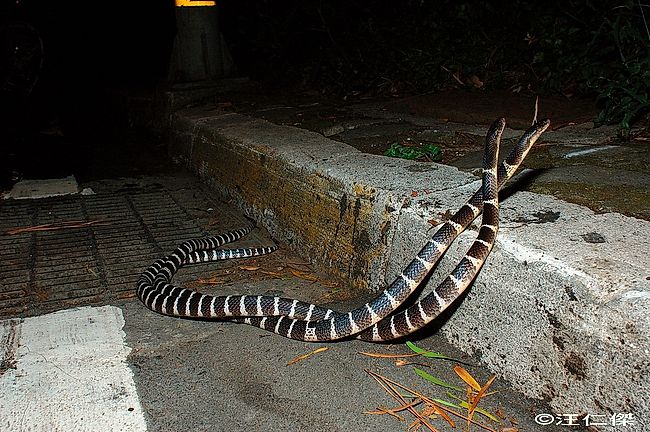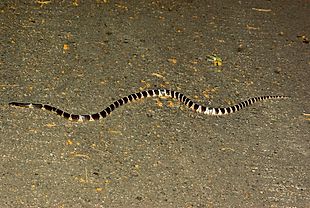Bungarus multicinctus multicinctus
Many-banded Krait
雨 傘節 (yu3san3jie2)
Status: Protected (Cat.II)
HIGHLY VENOMOUS!
Family
Elapidae, subfamily Elapinae
Max. length
180 cm
Occurrence in Taiwan
Common throughout Taiwan, Kinmen, and Matsu, up to 1000 m.
Global Distribution
Myanmar, Laos, N Vietnam, Thailand, Taiwan, South China (Hainan, Anhui, Sichuan, Guangdong, Guangxi, Hunan, Hubei, Yunnan, Guizhou, Jiangxi, Zhejiang, Fujian)
Description
Medium size; total length up to 180 cm. There are 15-17 rows of scales, which are smooth and glossy; one row of large hexagonal scales runs along the vertebral line. Head is a broad oval, body is moderately slender and slightly compressed; tail is short. Eye is small and bead-like; iris is blue-black and indistinct since it blends with the dark head. Pupil is round and also blue-black, and blends with rest of the eye. Tongue is red to flesh-colored, with a red stem and diffuse gray branches. The upper head is black and the lower part of supralabials cream to dark white. The fangs are short, rigid, and located in the upper jaw between eye and nose. A distinct pattern of regular black and white/mottled gray bands runs along the entire upper body. The anterior black bands are generally broader than the white bands. ** Ventral head and neck are dirty white or clouded with diffuse gray pigment; the infralabials may possess longitudinal narrow bars of pigment on the inner margins. Anterior section of the Ventral body is dirty white to cloudy gray, while the posterior section is progressively darker. Dorsal bands extend onto outer fifth to third of the ventrals. Underside of tail bears a continuation of dorsal bands. Anal scale is whole and the subcaudals are not divided. There is a wide range in coloration in this species. The bands of some individuals are light gray to light blue gray, light tan, or practically nonexistent.
Biology & Ecology
This nocturnal snake inhabits humid environments on mountain slopes and in agricultural areas. It feeds on frogs, lizards, fish, mice, snakes (even those of its own species) or snake eggs. It mates in August and September; females produce 3-20 eggs of 3-5 x 1.6-1.9 cm per clutch in late spring and summer. Hatchlings measure about 25 cm in total length.
B. m. multicinctus produces the most powerful venom of any terrestrial snake outside Australia. The tooth marks from a B. m. multicinctus bite are indistinct, and the wound site evinces neither swelling nor excessive bleeding. Victims frequently are unaware they have even been bitten at all, as the initial symptom is generally only a slight itchiness at the bite wound site. Within hours or even minutes, however, vision begins to blur, cramps, spasms and muscle paralysis sets in and respiratory functions begin to weaken, as the neurotoxic venom begins to take effect. The mortality rate of bite victims who do not receive antivenom treatment is reported to be as high as 85%.
While B. m. multicinctus packs a powerful neurotoxic punch, it is not aggressive at all and seldom attempts to bite unless threatened or provoked. When disturbed, it will almost always either freeze to avoid detection, or try to flee.
Among the more prominent victims of B. m. multicinctus was Dr. Joseph "Joe" Slowinski, an American herpetologist who specialized in kraits and other elapids. In September 2001, while doing research deep in an isolated region of Myanmar, Dr. Slowinski was bitten by a juvenile B. m. multicinctus. Despite the furious efforts of his comrades to keep him alive, the lack of adequate medical care or access to krait antivenom in the isolated jungle location proved to be insurmountable obstacles, and Dr. Slowinski died 28 hours later from the effects of the bite.
Etymology
Bungarum = Bengali term for a terrestrial serpent;
multicinctus = many-banded.
The Chinese name 雨傘節 (yu3san3jie2) means "umbrella segments", a reference to the triangular pattern on the body cross-section.
Notes
Under poorly lit conditions, the harmless Formosa Wolf Snake (Lycodon ruhstrati ruhstrati) appears very similar to B. m. multicinctus, which has led to the death of many a Wolf Snake at the hands of frightened humans. Under sufficient light, however, there is no mistaking the dangerous one: B. m. multicinctus has very sharply separated black and white bands and a triangular body cross-section, while Lycodon sports additional grey-brown bands, and the borders between the rings are more indistinct.
Further Info



































